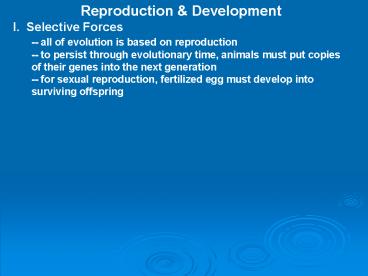Reproduction - PowerPoint PPT Presentation
1 / 12
Title:
Reproduction
Description:
Reproduction & Development I. Selective Forces-- all of evolution is based on reproduction-- to persist through evolutionary time, animals must put copies of their ... – PowerPoint PPT presentation
Number of Views:155
Avg rating:3.0/5.0
Title: Reproduction
1
Reproduction Development I. Selective
Forces -- all of evolution is based on
reproduction -- to persist through evolutionary
time, animals must put copies of their genes into
the next generation -- for sexual reproduction,
fertilized egg must develop into surviving
offspring
2
Reproduction II. Asexual vs. Sexual
Reproduction A. Asexual reproduction --
only one parent -- no reproductive organs --
no meiotically produced gametes (sex cells) no
fertilization or zygote formation --
offspring are genetically identical to parents
(clones)
3
Reproduction II. Asexual vs. Sexual
Reproduction A. Asexual reproduction 1.
advantages -- pass on 100 of genome to
each offspring -- all individuals can
produce offspring directly -- can occur
rapidly rapid exploitation of resources
-- saves energy and resources (no gonads or
gametes, no finding mates, no
courtship, no STDs, no males) 2.
disadvantages -- no genetic variability in
offspring (except for random mutations) --
limited ability to respond to changing
environment
4
Reproduction II. Asexual vs. Sexual
Reproduction B. Sexual reproduction --
usually involves two parents -- reproductive
organs -- haploid gametes produced by meiosis
fertilization ? diploid zygote -- offspring are
genetically unique 1. disadvantages --
pass only 50 of genome to each offspring
-- energy expended for gonads and gametes
-- production of males (many fail to mate)
-- is complicated occurs more slowly --
requires finding mates, courtship, --
STDs 2. advantages -- increased
genetic variability in offspring --
ability to respond to changing environment, esp.
biotic environment
5
Reproduction III. Mechanisms of Asexual
Reproduction A. Fission animal divides by
mitosis
Binary fission Paramecium
Multiple fission Plasmodium
6
- Binary Fission
- Asexual
- Cell splits and replicated DNA goes with each
part - Prokaryotes, Bacteria
- Fast and easy
- - Everybody has the same DNA
7
- Bacterial Conjugation
- Asexual Sex
- A bacteria shoots out a tube and sends a piece of
its DNA to another bacteria - Bacteria
- Mixes DNA
- - Parent loses a little piece of DNA
8
Fragmentation/ Regeneration
- Asexual
- Body of parent breaks and produces offspring
- Fungi, moss, sea stars, planarian
- Easy
- - Parent broken, same DNA
9
Fragmentation/ Regeneration
10
Reproduction III. Mechanisms of Asexual
Reproduction B. Budding new individual arises
from outgrowth of parent
11
Reproduction III. Mechanisms of Asexual
Reproduction C. Gemmulation Poriferans --
formation of new individual from aggregation of
asexual cells encased in resistant capsule (
gemmule)
12
Vegetative Propagation
Vegetative propagation is a form of asexual
reproduction of a plant. Only one plant is
involved and the offspring is the result of one
parent. The new plant is genetically identical
to the parent
New plants grow from parts of the parent plant
The parts of the original plant include the
roots, stems, leaves and bulbs.

